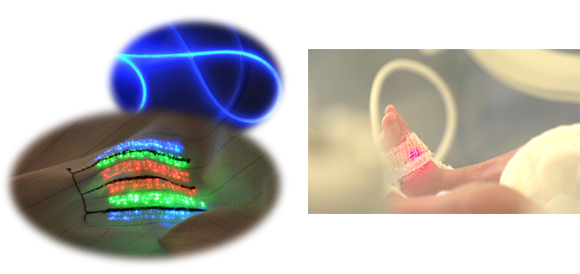Wearables for Health
Healthy ageing and the prevention of chronic diseases are key challenges of our society. Wearables are increasingly being used for long-term monitoring of body parameters and as diagnostics devices. For such applications, these wearables have to be as reliable and precise as standard diagnostic tools used in hospitals. Furthermore, they have to be comfortable and easy to use to ensure a high degree of compliance.

The goal of the module "Wearables for Health" are the following:
- We develop multiparametric body monitoring technologies for the early detection of health condition and disease prevention
- For this, we develop sensors for long-term, quantitative health monitoring to rationalize the decision-making process based on computational multiphysics and artificial intelligence methods.
We develod physical and chemical sensors with polymer optical fibers, nanofiber meshes, or hydrogels as substrates. Modification of the substrate with sensitive moieties (e.g. fluorophores, chromophores), or the simple integration into textiles, allows detection of gases, liquids, biomolecules, body vital pa-rameters, and microorganisms. Detection occurs by changes in light intensity, wavelength, and/or fluo-rescent intensity.

CMOS compatible silicon nanowires (SiNWs) operated as ion-sensitive field-effect transistors (ISFETs) can function as chemical and biochemical sensors. In these devices, the gate metal of the transistor is replaced by the solution carrying the analyte species. The reactions of charged analytes with ligand groups at the sensor surface cause a change of the electrical surface potential at the gate contact. This change in surface potential is detected as a shift in the transistor transfer function and can be quantita-tively related to the number of adsorbed analytes.



-
Share
